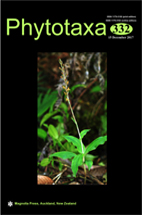Abstract
A new poroid wood-inhabiting fungal species, Atraporiella yunnanensis sp. nov., is proposed based on morphological and molecular characters. The species is characterized by cream pore surface when dry, which is easy to separate from substrate and very rapidly stained dark brown to black when bruised; hyphal system monomitic with generative hyphae hyaline to pale brown, thin-walled, unbranched, interwoven; slightly allantoid basidiospores, 2.2–3 × 0.8–1.5 µm. The internal transcribed spacer (ITS) and the large subunit (LSU) regions of nuclear ribosomal RNA gene sequences of the studied samples were generated, and phylogenetic analyses were performed with maximum likelihood, maximum parsimony and bayesian inference methods. The phylogenetic analysis based on molecular data of ITS+nLSU sequences showed that Atraporiella yunnanensis belonged to the residual polyporoid clade, formed a monophyletic lineage with a strong support (100% BS, 100% BP, 1.00 BPP) and was closely related to A. neotropica, and then grouped with other related genera: Antrodiella, Pouzaroporia, Steccherinum and Xanthoporus. Both morphological and molecular characters confirmed the placement of the new species in Atraporiella.

